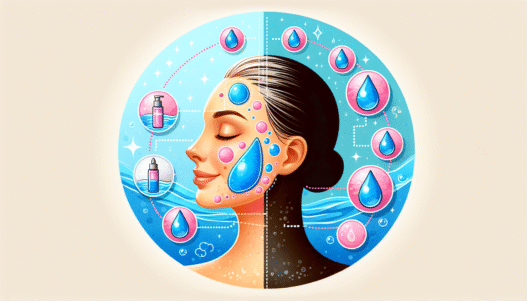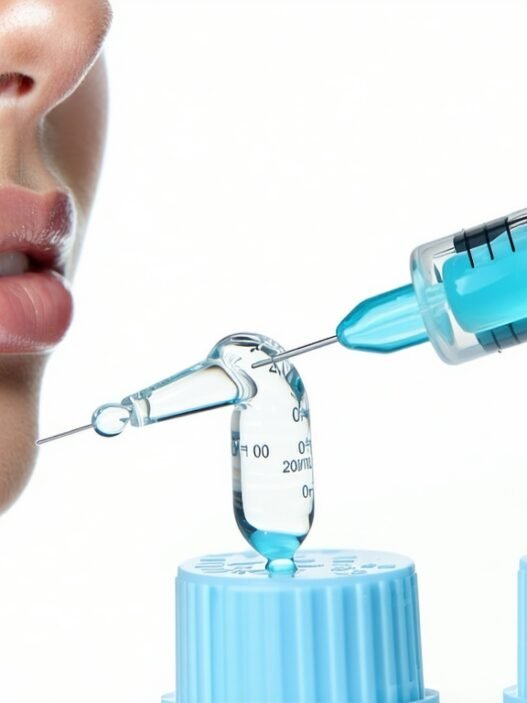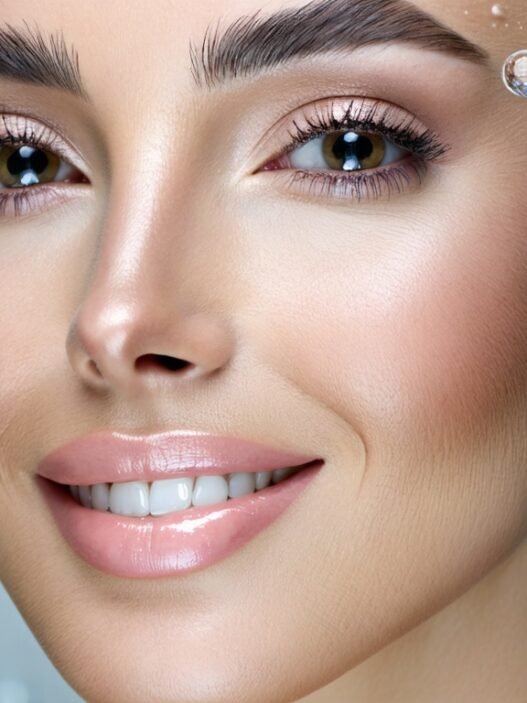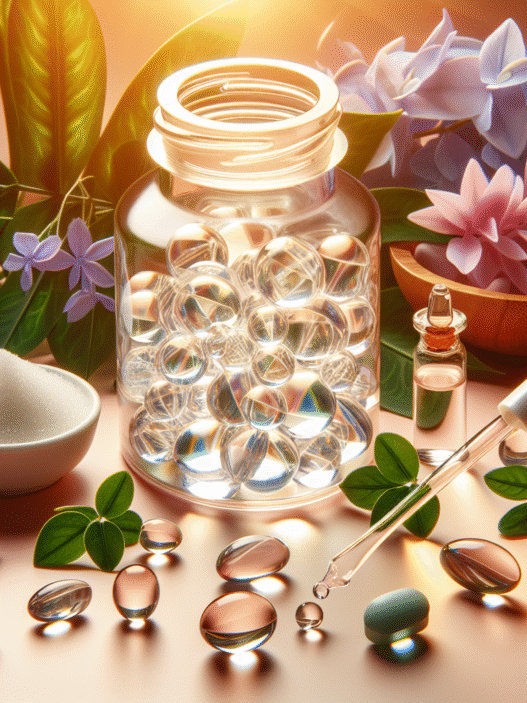Understanding Hyaluronic Acid
What is Hyaluronic Acid?
Hyaluronic Acid (HA) is a powerful humectant that occurs naturally in the body, particularly in the skin, eyes, and synovial fluid of the joints. It has the remarkable ability to bind over one thousand times its weight in water, making it a key player in maintaining skin hydration and overall moisture levels. As individuals age, the natural production of HA diminishes, leading to a decrease in skin volume, hydration, and plumpness (Harvard Health Publishing).
Benefits of Hyaluronic Acid
The applications of hyaluronic acid in skincare are numerous. It provides various benefits that can enhance skin health and appearance.
| Benefit | Description |
|---|---|
| Hydration | HA draws and locks in moisture, significantly increasing skin hydration levels. A study found that using topical nano hyaluronic acid in lotion, cream, or serum form for 8 weeks led to improved skin hydration. |
| Improved Skin Texture | Hyaluronic acid can smooth skin texture and reduce roughness, contributing to a younger-looking complexion (Cetaphil). |
| Enhanced Elasticity | Topical application of HA may boost skin elasticity, helping to minimize the appearance of fine lines and wrinkles while providing anti-aging benefits. |
Overall, hyaluronic acid serves as a vital component in both maintaining skin health and combating signs of aging. It’s essential for those curious about skincare to consider how HA can play a role in their routines, especially when questioning does hyaluronic acid remove dark spots? and its overall effectiveness in promoting a healthier appearance.
Hyaluronic Acid for Skin Health
Hyaluronic acid is renowned for its remarkable benefits to skin health, serving as a key ingredient in many beauty products. Its ability to retain moisture makes it a valuable ally for maintaining hydrated and supple skin.
Topical Application of Hyaluronic Acid
The topical application of hyaluronic acid can significantly enhance skin hydration and texture. By forming a protective barrier on the skin’s surface, hyaluronic acid helps to lock in moisture, resulting in a plumper and more youthful appearance. This capability is one reason why many skincare routines now incorporate products containing hyaluronic acid. According to the Cleveland Clinic, both serums and moisturizers often utilize this ingredient to improve skin hydration levels.
| Benefit | Description |
|---|---|
| Deep Hydration | Provides moisture retention |
| Enhanced Elasticity | Improves skin flexibility and softness |
| Plumping Effect | Gives skin a fuller appearance |
The use of hyaluronic acid in serums allows for deeper penetration into the skin, ensuring that hydration reaches the layers where it matters most. For more insights into hyaluronic acid’s effects, check our article on what does hyaluronic acid do to your skin?.
Long-term Effects on Skin
Long-term use of hyaluronic acid, whether through serums or oral supplements, brings a range of benefits. Continuous application can lead to improved overall skin health, enhanced flexibility, and increased elasticity (Cleveland Clinic). As skin becomes more pliable, it can better withstand environmental aggressors, reducing the appearance of fine lines and supporting a more resilient complexion.
| Long-term Effects | Description |
|---|---|
| Improved Flexibility | Makes skin stretchier and softer |
| Enhanced Elasticity | Helps maintain youthful skin structure |
| Overall Skin Health | Promotes healthier, radiant skin |
Incorporating hyaluronic acid into daily skincare routines not only provides immediate hydration but also encourages lasting improvements in skin quality over time. For those considering mixing it with other ingredients, explore our guide on what not to mix with hyaluronic acid? to ensure optimal results.
Hyaluronic Acid for Acne Scars
Use in Fillers for Acne Scars
Hyaluronic acid (HA) is widely utilized in dermal fillers to repair or conceal scars left behind by acne. This approach is effective for individuals seeking to improve the appearance of their skin, as HA can add volume and hydration. Injectable HA fillers are particularly beneficial because they work to replace lost volume in areas affected by acne scarring, while also encouraging collagen formation, which can enhance skin texture and elasticity (Cleveland Clinic, PMC).
By carefully injecting hyaluronic acid into the depressed areas of scars, practitioners can smooth out uneven skin surfaces, leading to a more youthful and refreshed appearance. While this treatment does not directly remove dark spots, it can significantly improve the overall skin texture, helping to diminish the visibility of scars.
| Type of Treatment | Expected Benefits |
|---|---|
| Hyaluronic Acid Fillers | Adds volume, smooths scars, promotes collagen formation |
Combination Treatments for Acne
Combining hyaluronic acid with other treatments can enhance results for individuals addressing acne scars. Although research on synergistic effects is limited, some dermatologists may suggest pairing HA with treatments like retinol or vitamin C. These combinations can work together to improve skin texture, promote healing, and provide hydration.
Topical hyaluronic acid can also be beneficial when used alongside laser treatments or microneedling. While topical HA provides hydration at the surface level, these techniques can penetrate deeper into the skin, enhancing overall treatment efficacy and results. Patients should consult with qualified dermatologists to discuss the best combination options tailored to their skin type and concerns.
For a deeper look into the effects of hyaluronic acid on skin health, refer to our article on what does hyaluronic acid do to your skin?.
Safety of Hyaluronic Acid Products
The safety of hyaluronic acid products is a crucial consideration for beauty and skincare enthusiasts looking to address various skin concerns, including dark spots and signs of aging. This section discusses both over-the-counter and prescription products containing hyaluronic acid.
Over-the-counter Products
Hyaluronic acid products available over-the-counter are generally regarded as safe for most individuals. These include serums, lotions, and eye care products. According to the Cleveland Clinic, applying these products to the skin can provide hydration without significant risks. Many users enjoy the benefits of smoother and more supple skin.
| Product Type | Common Forms | Safety Rating |
|---|---|---|
| Serums | Gel-based, liquid | Safe |
| Moisturizers | Creams, lotions | Safe |
| Eye Care Products | Creams, serums | Safe |
| Supplements | Oral capsules | Safe (with consultation) |
While over-the-counter hyaluronic acid products are generally safe, it’s essential to consider personal skin sensitivities. For further insights on using hyaluronic acid effectively, refer to what does hyaluronic acid do to your skin?.
Prescription Products
Prescription hyaluronic acid products should be used under the guidance of a healthcare professional. These products may include injectable fillers designed to add volume or smooth out specific areas of the face. Proper administration is critical; injections must be performed by a licensed medical professional to prevent complications and ensure safety. The Cleveland Clinic notes that people should strictly follow their healthcare provider’s instructions regarding these treatments, as improper use can lead to adverse effects.
| Product Type | Common Uses | Safety Precautions |
|---|---|---|
| Injectable Fillers | Volume enhancement | Administered by licensed professionals |
| Prescription Creams | Targeted skin treatments | Follow healthcare provider guidance |
When combining hyaluronic acid with other treatments, it is important to consult a healthcare provider as the evidence for its effectiveness alongside other medications is limited. For individuals curious about what not to mix with hyaluronic acid, check our article on what not to mix with hyaluronic acid?.
Safety remains a foremost consideration when using hyaluronic acid products, whether they are over-the-counter or prescription. Always prioritize professional advice and personal comfort when selecting skin care products.
Hyaluronic Acid and Anti-aging
Effects on Dark Spots
Hyaluronic acid has been recognized for its ability to hydrate and plump the skin, which can also play a role in addressing hyperpigmentation, including dark spots. Research suggests that hyaluronic acid can help lighten dark spots by promoting cell turnover and nourishing the skin, thereby improving its overall appearance (Garnier). Incorporating hyaluronic acid into a skincare routine may enhance the effectiveness of other products aimed at reducing hyperpigmentation.
To optimize the benefits of hyaluronic acid, it is advised to use it on cleansed skin, whether in the form of a serum, moisturizer, or night cream. Additionally, using a hyaluronic acid sheet mask can provide concentrated treatment for dark spots.
| Method of Use | Benefits |
|---|---|
| HA Serum | Lightweight hydration, promotes cell turnover |
| Moisturizer with HA | Continuous hydration throughout the day |
| Night Cream | Intensive overnight treatment |
| Sheet Mask | Targeted treatment for dark spots |
It is critical to combine hyaluronic acid treatments with sun protection. Using a broad-spectrum sunscreen with an SPF of 50+ is recommended to prevent further pigmentation and ensure optimal skin health.
Anti-aging Benefits
Hyaluronic acid serves as a key player in anti-aging skincare routines. It helps maintain skin elasticity and reduces the appearance of fine lines and wrinkles. By boosting collagen production and providing hydration, hyaluronic acid can significantly improve skin texture and firmness (Harvard Health Publishing).
There are two types of hyaluronic acid based on molecular size: larger molecules provide surface-level hydration, while smaller molecules can penetrate the epidermis for deeper moisture. For more substantial anti-aging results, injectable hyaluronic acid fillers may be considered, as they effectively replace lost volume and combat skin laxity related to aging.
Including hyaluronic acid along with complementary ingredients such as vitamin C can compound its effects, as both ingredients work synergistically to boost hydration and protect against skin damage. For further insights, check our article on what do vitamin c and hyaluronic acid do?.
In summary, hyaluronic acid not only hydrates but also aids in diminishing dark spots and combating signs of aging, making it an essential component in any skincare routine focused on maintaining youthful, radiant skin. For optimal results, individuals should be mindful of product selection and application techniques.
Best Practices for Hyaluronic Acid
Incorporating hyaluronic acid into a skincare routine can be highly beneficial, especially for those aiming to address dark spots. Here are some best practices to maximize its effectiveness.
Pairing with Vitamin C
Combining hyaluronic acid with vitamin C can enhance results, particularly in treating hyperpigmentation. This powerful duo works synergistically, as vitamin C helps brighten the skin and reduce dark spots, while hyaluronic acid hydrates and plumps the skin. It is recommended to apply these two ingredients together for optimal outcomes (Garnier).
| Ingredient | Benefits |
|---|---|
| Hyaluronic Acid | Hydrates, plumps, promotes cell turnover |
| Vitamin C | Brightens, reduces dark spots |
To effectively incorporate both into a routine, it is advisable to apply a vitamin C serum followed by a hyaluronic acid serum. This layering technique allows each ingredient to penetrate the skin effectively.
Application Tips and Recommendations
For the best results when using hyaluronic acid, consider the following application tips:
-
Cleanse the Skin: Always begin with a clean face to ensure optimal absorption of products. Use a gentle cleanser suitable for your skin type.
-
Apply on Damp Skin: For maximum hydration, apply hyaluronic acid on slightly damp skin. This helps to lock in moisture, enhancing its effects.
-
Use a Serum or Moisturizer: Options include using a hyaluronic acid serum, a moisturizer infused with hyaluronic acid, or a night cream. Choose a product that best fits your skincare regimen (Garnier).
-
Pat Gently: After applying hyaluronic acid, use a gentle patting motion with fingertips to aid absorption into the skin.
-
Consider a Sheet Mask: Using a sheet mask that contains hyaluronic acid can provide an intensive treatment for hydration and skin renewal.
-
Sunscreen Protection: To prevent further pigmentation, apply a broad-spectrum sunscreen with an SPF of 50+ daily. Sun protection is crucial in any skincare routine, particularly when addressing hyperpigmentation.
By following these practices, one can harness the potential of hyaluronic acid effectively, contributing to a healthier and more radiant complexion. For more insights on what hyaluronic acid can do, check out our article on what does hyaluronic acid do to your skin?.





















